Biochemistry
Prices subject to change without prior notice.
Click on an image to enlarge.
Click on the part number to view the instructions.
| Kit Name | Part # INSTRUCTIONS/LAB ACTIVITES | Description | Price US $ |
| AMINO ACIDS (SMALL SET) 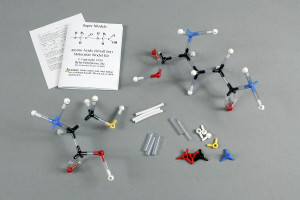 | AA-1 | Kit Contents: 20 white 1-peg hydrogen atom centers 4 blue 4-peg nitrogen atom centers 7 red 2-peg oxygen atom centers 2 yellow 2-peg sulfur atom centers 9 black 4-peg carbon atom centers 32-1.25" PVC, clear bonds (single bonds) 7-1.625" PVC, clear bonds (double bonds) 3-2" PVC, white bonds (H bonds) Lab procedure and Answer key PDF on this website. Students can build three amino acids simultaneously with this kit to investigate D and L isomers of amino acids, hydrogen bonding, dehydration synthesis, peptide formation, the meaning of "alpha amino acid", primary and secondary structures of proteins, and amines such as GABA and epinephrine. As separate investigations, students can make models of each of the common 20 alpha amino acids. | $15.00 |
| AMINO ACIDS (LARGE SET) 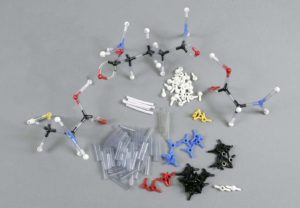 | AA-2 | Kit Contents: 52 white 1-peg hydrogen atom centers 2 white 2-peg hydrogen atom centers 2 blue 4-peg nitrogen atom centers 9 blue 3-peg nitrogen atom centers 14 red 2-peg oxygen atom centers 2 red 3-peg oxygen atom centers 3 yellow 2-peg sulfur atom centers 22 black 4-peg carbon atom centers 7 black 3-peg carbon atom centers 90-1.25" PVC, clear bonds (single bonds) 14-1.625" PVC, clear bonds (double bonds) 3-2" PVC, white bonds (H bonds) Lab procedure and Answer key PDF on this website. Students can build a five amino acids simultaneously with this kit to investigate D and L forms of amino acids, hydrogen bonding, dehydration synthesis, peptide formation, the meaning of "alpha amino acid", primary and secondary structure of proteins. As separate investigations, students can make models of each of the common 20 alpha amino acids. | $35.25 |
CHEMISTRY OF LIFE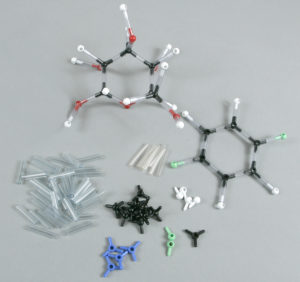 | COL-1 | Kit Contents: 15 black 4-peg carbon atom centers 7 black 3-peg carbon atom centers 6 red 2-peg oxygen atom centers 4 blue 3-peg nitrogen atom centers 20 white 1-peg hydrogen atom centers 4 green 1-peg halogen atom centers 40-1.25" PVC, clear bonds (single bonds) 8-1.625" PVC, clear bonds (double bonds) Lab procedure and Answer key PDF on this website. Students use this kit to investigate the structures of a wide variety of biochemicals. Instructions first take students through building examples of several functional groups, followed up with making models of about 20 important biochemicals such as vitamin C, urea, serotonin, glucose, a low molecular weight triglyceride, aspirin, aspartame, etc. | $18.70 |
CHEMISTRY OF SUGARS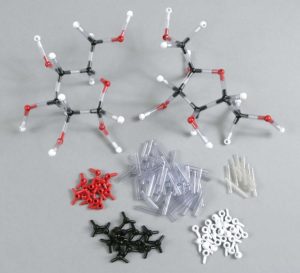 | SUG-1 | Kit Contents: 26 black 4-peg carbon atom centers 26 red 2-peg oxygen atom centers 50 white 1-peg hydrogen atom centers 90-1.25" PVC, clear bonds (single bonds) 10-1.625" PVC, clear bonds (double bonds) Instructions for assembly PDF on this website. | $31.70 |
DNA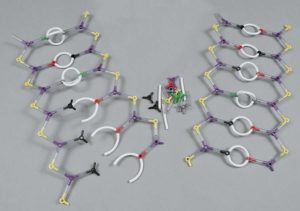 | DNA-1 | Kit Contents: 25 purple3-peg sugar 25 yellow 2-peg phosphate 9 red 3-peg adenine 9 black 3-peg thymine 5 green 4-peg cytosine 5 silver 4-peg guanine 75-1.25" PVC, clear bonds (single bonds) 31-2" PVC, white bonds (H bonds) Lab procedure and Answer key PDF on this website. This kit gives students a chance to "handle" a molecule of DNA by first constructing 24 nucleotides from sugars, bases, and phosphates. The nucleotides are then assembled into a DNA duplex containing 12 base pairs. Different colored tubes, used for bonds, highlight the difference between ordinary covalent and hydrogen bonding. The kit can be used to show a variety of base sequences and the point mutation that causes sickle cell anemia. Use of the kit can also be integrated with a study of the dictionary of the genetic code, transcription, and translation. When used together, three or four sets can illustrate DNA's helical form or replication of the molecule. | $29.17 |
GLYCERIDES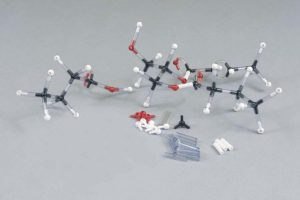 | GLY-1 | Kit Contents: 33 white 1-peg hydrogen 10 red 2-peg oxygen 16 black 4-peg carbon 50 clear, 1.25" PVC, bonds 10 clear, 4cm bonds 5 white, .87" bonds Lab procedure and Answer key PDF on this website. There are enough carbon atoms in this kit to make a triglyceride that has three butyric acid residues. The kit also demonstrates dehydration synthesis and hydrolysis, mono- and polyunsaturated fatty acids, the nature of a soap, the nature and function of phospholipids, and, using all the carbon atoms, longer chain fatty acids | $19.70 |
HOT & SPICY MOLECULES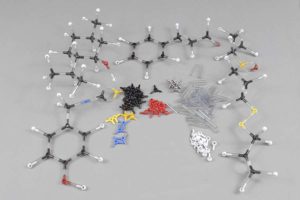 | HOT-1 | Kit Contents: 65 white 1-peg hydrogen atom centers 5 blue 3-peg nitrogen atom centers 14 red 2-peg oxygen atom centers 4 yellow 2-peg sulfur atom centers 3 yellow 4-peg sulfur atom centers 3 silver 6-peg sulfur atom centers 40 black 4-peg carbon atom centers 13 black 3-peg carbon atom centers 138-1.25" PVC, clear bonds (single bonds) 18-1.625" PVC, clear bonds (double bonds) Instructions PDF on this website. Great activity for junior high through college biology students. A listing of 31 spices and their constituent compounds is contained in the accompanying booklet. The molecular structures of 63 spicy compounds guide students in making models. | $47.50 |
NUCLEIC ACID BASES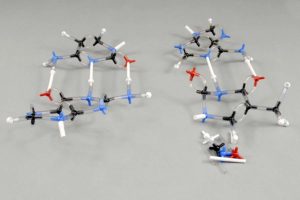 | NUC-1 | Kit Contents: 20 black 4-peg carbon atom centers 13 white 1-peg hydrogen atom centers 6 white 2-peg hydrogen atom centers 7 black 3-peg carbon atom centers 16 blue 4-peg nitrogen atom centers 5 red 4-peg oxygen atom centers 45-1.25" PVC, clear bonds (single bonds) 30-1.625" PVC, clear bonds (double bonds) 7-2" PVC, white bonds (H bonds) 5-.75" PVC, white bonds (glycosidic bonds) Lab procedure and Answer key PDF on this website. Build and H bond adenine to thymine, and guanine to cytosine. Other N bases (uracil, caffeine, theophylline, and theobromine) can also be made with the kit. | $22.60 |
NUCLEOTIDES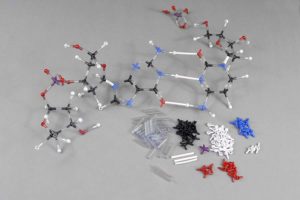 | NUC-2 | Kit Contents: 60 white 1-peg hydrogen atom centers 16 blue 4-peg nitrogen atom centers 5 red 4-peg oxygen atom centers 25 red 2-peg oxygen atom centers 40 black 4-peg carbon atom centers 3 purple 5-peg phosphorous atom centers 128-1.25" PVC, clear bonds (single bonds) 30-1.625" PVC, clear bonds (double bonds) 6-2" PVC, white bonds (H bonds) 5-.75" PVC, white bonds (glycosidic bonds) Lab procedure and Answer key PDF on this website. Students construct the common bases, A, G, C, T (alternately U), bond them to a deoxyribose (or ribose) model which is bonded to phosphate. The nucleotides of DNA are then hydrogen bonded to show two bases pairs. A short strand of RNA can also be demonstrated. | $48.40 |
